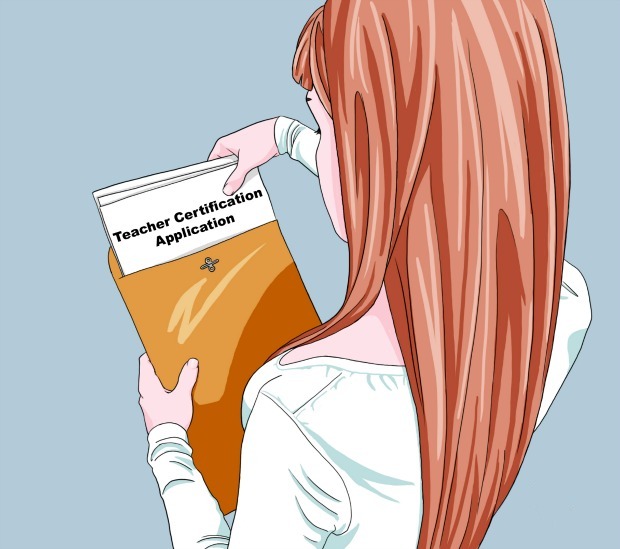If you want to be an elementary school teacher in Alaska, you will need to become certified by the standards of the Alaska Department of Education and Early Development (EED). Even if you have been certified in another state, you will still need to show that you have met Alaska’s specific teacher education requirements.
Step 1 Enroll in a Teacher Education Program. You may not seek certification in Alaska until you have earned at least a Bachelor’s degree from an accredited institution.
In addition, you will have to participate in a state-approved certification program for elementary teachers. Don’t worry if you are still working on your certification pro-gram, though. As long as you’ve received your degree and are enrolled in a sanctioned pro-gram, you can still apply for initial certification.
 Step 2 Get a criminal history background check. All Alaska teacher candidates are required to submit to a state and federal background check. This is a simple procedure that uses your fingerprints and personal information to search for any criminal history. It’s an important step in making sure that people who work with children are held to high standards of conduct. Make sure you have your fingerprinting done by one of the state’s approved organizations or individuals.
Step 2 Get a criminal history background check. All Alaska teacher candidates are required to submit to a state and federal background check. This is a simple procedure that uses your fingerprints and personal information to search for any criminal history. It’s an important step in making sure that people who work with children are held to high standards of conduct. Make sure you have your fingerprinting done by one of the state’s approved organizations or individuals.

Step 3 Take the Praxis examination. Next, you will have to pass a basic competency exam. There are several that comply with state standards, but the most commonly used is the Praxis I Pre-Professional Skills Test. Doing well on the exam is imperative, so make sure you study. There are some excellent online resources available to help you prepare, including this teacher’s test prep site and these materials found on the Praxis site. You may be asked to take the test prior to the completion of your teacher certification program.
 Step 4 Get the required Experience. To work as an elementary school teacher in Alaska, you must complete a period of supervised teaching. During this student teaching internship, you will work in a real classroom alongside a professional educator. This is an intrinsic part of preparing for your career. Nothing can ready you for the road ahead like practical experience.
Step 4 Get the required Experience. To work as an elementary school teacher in Alaska, you must complete a period of supervised teaching. During this student teaching internship, you will work in a real classroom alongside a professional educator. This is an intrinsic part of preparing for your career. Nothing can ready you for the road ahead like practical experience.
You’ll get a feel for the basics like creating lesson plans, grading papers, and managing a classroom. You’ll also learn how to handle various student issues in a consistent and appropriate way, how to interact productively with parents, and how to work well with other teachers and administrators. You will most likely have the opportunity to complete all of the necessary student teaching hours as part of (or concurrent with) your college coursework and/or your teacher certification program. The duration of your intern-ship will depend on the certification program you take, but is usually around one year long.
Standing in front of a full class for the first time can be nerve-wracking, but a little preparation can go a long way. As soon as you find out who your mentor will be, contact that person and introduce yourself. Ask him or her if there are any specific things you can do to ready yourself – and do them! Talk to others who have already done their internships for insights and advice. Finally, even though you’re technically still a student, always dress professionally and conduct yourself as if you were already working as a certified teacher.
 Step 5 Complete required documentation and Apply for Certification. You can find the initial certification application online, but you’ll need to print it out and send it in the mail to the following address:
Step 5 Complete required documentation and Apply for Certification. You can find the initial certification application online, but you’ll need to print it out and send it in the mail to the following address:
Teacher Education & Certification
801 West 10th Street, Suite 200
PO Box 110500
Juneau, AK 99811-0500
All applications must be submitted this way. (Once professionally certified, you will be able to submit your renewal forms electronically). When you mail your packet, double check to make sure you include the following items:
- Official transcripts from the school where you earned your degree
- Official transcripts from the institution where you received the required Alaska studies and multicultural credits, if complete
- Institutional recommendation form to verify enrollment in and/or completion of state-approved preparation program
- Proof of passing score on competency exam
- Completed application form, signed and notarized
- Fingerprint card
- Background check fee ($60)
- Application fee ($125)
Your initial certification will be valid for three years, during which time you will have to complete any remaining experience requirements along with some additional educational provisions spe-cific to the state of Alaska.